Travel Info
Ooty

Ooty - The Queen

Ooty History
Ooty or Udagamandalam (the Tamil version of the original name) rightly described as "Queen of Hill Stations" by Pandit Jawaharlal Nehru, now sprawls over an area of 36 sq km with a number of tall buildings cluttering its hill slopes. It is situated at an altitude of 2,240 meters above sea level. Ooty still woos people from all over India as well as foreign countries right through summer, and sometimes in the winter months too. An added attraction for the tourists to Udagamandalam is the mountain train journey on a ratchet and pinion track which commences from Kallar, near Mettupalayam and wends its way through many hair-raising curves and fearful tunnels and chugs along beside deep ravines full of verdant vegetation, gurgling streams and tea gardens.
The scenery, as it unfolds during the trip, is breathtaking, awe-inspiring and fantastic. One can notice a marvellous change in vegetation, as one goes from Kallar to Coonoor. At Kallar it is tropical and at Burliar-the next bus-stop as one proceeds from Mettupalayam-it is sub-tropical. Near Coonoor, it is humid with pines, blue gum (Eucalyptus globulus) and cypress trees. As we go from Ooty to Gudalur, the change in vegetation is striking. What a splendid interaction between climate and vegetation ! It is therefore very appropriate that Mount Stuart called the whole road leading to Ooty from Mettupalayam, "One long botanical debauch."
Tourist Attraction
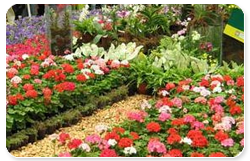
Ooty Rose Garden
Ooty has always been known for its flora. Apart from the famous botanical Gardens which has become synonymous with Ooty, The Rose Garden is also a must see sight in Ooty. It’s a divine site as you see stretches and stretches of vibrant colors of roses.
The Rose Garden of Ooty or the Centenary Rose Garden is spread across six acres of land in the slopes of Elk hills, located in the Vijayanagaram farms; Needless to say, it is the largest rose garden in the country. There are large varieties of roses including some rare species as well. There are about 17000 varieties of rose plants. The important feature of the Rose Garden is that, it has been recognized by the world federation of rose societies. Another distinction is that it is the first Rose Garden in India that has been recognized as the “Garden of Excellence”. Truly a must see place in Ooty.
Ooty Lake
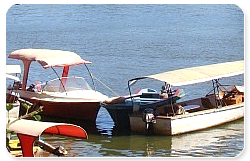
If you have been to Ooty and not seen the Ooty Lake, then you have seen nothing at all. The Lake is synonymous with Ooty itself. This is an artificial lake that was initiated as ling back as 1823 by the then collector of Coimbatore Mr. John Sullivan. The lake has been formed by throwing a dam through a narrow outlet of the valley. The Origin of the Lake is as old as the discovery of Ooty by Mr. Sullivan.
The Ooty Lake has a lot of aquatic vehicles in its stock by which the tourists can indulge in their trip across the lake. Row boats, paddle boats or motor boats can be hired and proves to be very exciting. The big boat jetty here is very attractive to children. A mention of the Ooty Lake is incomplete without the mention of boat house that is maintained by the Tamilnadu Tourism Development Corporation. This is also a major attraction of the lake.
Ooty Botanical Garden

The Botanical Garden of Ooty is the backbone of Ooty tourism. The Botanical Garden dates back to 1847 and was laid out by the Marquis of Tweedale. This garden is spread out over 55 acres. The garden has such a spectacular collection of flora that it is a delight for any Botanist. The Botanical Garden of Ooty is maintained by the Department of Horticulture of the Government of Tamilnadu.
The highlights of the Botanical Garden are the well maintained lawns, a 20 million year old fossiled tree, rare species of trees, fern house with a vast range of ferns and orchids, a colorful collection of flowering bushes and shrubs. Another attraction is the Italian-style garden bordering a clear pool. The botanical garden is famous for its summer festival where the flower show is held. It is held usually during the months of May. The Garden is also famous for the Toda hill called the Toda mund. This place is important in that it gives us a great insight into the lives of the original tribals of Ooty called the Todas.
Pykara Falls Ooty
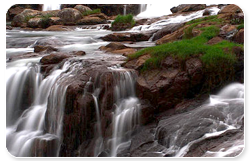
Ooty is known for its natural splendor in the form of lakes, rivers, waterfalls and Gardens. Among the must see places of Ooty is the Pykara waterfalls. This is a popular tourist destination, famous for its natural beauty.
Pykara waterfalls are on the path from Ooty to Bangalore. The Pykara Lake is a beautiful lake with an abundance of natural beauty. The Pykara Lake is a great place for boating. It falls across in the form of waterfalls in two places which are known as the Pykara falls. It’s a great place for photography. Truly a nature lover's delight. As it’s not too far from Ooty, it is easy to access by road. The bridge here allows one to take great shots of these falls.
Upper Bhavani Lake Ooty
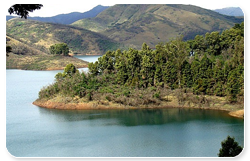
Ooty is a place drenched with natural beauty. The place is popular for its beautiful, hills, valleys, gardens and lakes. Out of the lakes, the Upper Bhavani Lake and the sanctuary are extremely popular. It has a mesmerizing effect on the tourists who visit it.
The Upper Bhavani Lake is characterized by water throughout the year. There has been a dam constructed here named the Upper Bhavani Dam which provides water for irrigation and to nearby settlements. This dam has been responsible for most of the successful agricultural activities around the place. The Upper Bhavani sanctuary is spread over 70 sq km of land. The Nilgiri Tahr can be found here. The sanctuary also is home to such animals like includes tigers, jackals, jungle cats, wild dogs, Sambhar, giant squirrels, Nilgiri langurs, and leopards.
Ooty toy train history
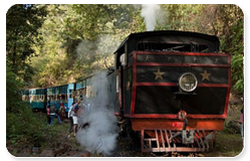
Our experience
This toy train service was first started between Coonoor and Metupalyam during 1899. But the line was extended upto Ooty during 1908. The passenger service was started on 15.10.1908 from Ooty to Coonoor. This is the only heritage train and runs at the highest elevated place in Southern India. The service comes under Niligiri Mountain Railway (NMR) and is a major tourist attraction. Approximately 5lakh people travel every year in this toy train. Below are few of our experience during this journey by the train.
We left Mettupalayam at 7.30 AM and the train started traveling at a speed of not more than 12 KM/hour. This train covers a distance of 46Km in a five hours journey passing through Hilligrove, Coonoor, Wellington, Aravankadu, Keeti, Lovedale stations and finally ends at Udagamandalam or Ooty. At the starting of the journey for nearly half hour the train traveled through Jungle but plain area. The hills started after that and temperature started falling as we climbed up. During every start in the hill slopes the engine gives a jerk in trying to push the train from behind. After traveling three or four KM in the hills, train stopped as one tree has fallen and cutting and removing work was going on. After a brief stop of 10 minutes train started climbing again. Lights inside the compartments were switched on as the train started moving inside the dark tunnels. There were few long tunnels and most of the tunnels were short in length. There were water in the small rivers and water falls even during the month of pick summer (month of May). During the journey most of the time the valley was in the left side of the train. The road from Mettupalayam to Ooty was visible from the train and was crossing the train line in many places
Festivals
IMPORTANT FESTIVALS
Thaipoosam in Elk Hill Murugan Temple (February), Bookkapuram Mariamman Annual Festival (February), Ooty Mariamman Temple Festival (April), Coonoor Mariamman Temple Festival (April), Boat Races and Boat Pageantry in Ooty (May), Flower show in Ooty (May) and Fruit show in Coonoor (May).
SUMMER FESTIVAL
In summer, regular cultural programmes, fashion parade, flower and fruit shows are arranged. During summer festival Boat races, Boat pageantry, dog show etc., add more festivity to the celebration. All these are jointly organised by the Department of Tourism, Government of Tamil Nadu and Ministry of Tourism, Government of India. There is also a Tea and Tourism Festival Ooty in January.
IMPORTANT TELEPHONE NUMBERS :
Railway Enquiry - 2442246
Bus Enquiry - 2443970
Government Hospital - 2442212
Tourist Officer - 2443977
Fire Service Station - 2442999
TTDC Youth Hostel- 2443665
Coimbatore
Coimbatore - Manchester of South India
Coimbatore also known as Kovai, is the second largest city in the state of Tamil Nadu.It is the administrative headquarters of Coimbatore District. Known as Manchester of southern India, it is also a part of the Kongu Nadu region of Tamil Nadu.
Situated on the banks of the Noyyal River, Coimbatore is known for its textile factories, engineering firms, automobile parts manufacturers, health care facilities, educational institutions, pleasant weather, hospitality and for its Kongu Tamil.
Coimbatore is the third largest city in Tamilnadu, With a population of more than 15 lakhs. There are more than 30,000 tiny small, medium and large industries and textile mills. The city is known for its entrepreneurship of its residents. The climate is comfortable round the year.
The city is situated on the banks of the river Noyyal. Coimbatore existed even prior to the 2nd Century AD as a small tribal village capital called Kongunad until it was brought under Chola control in the 2nd or 3rd Century AD by Karikalan, the first of the early Cholas. When Kongunad fell to the British along with the rest of the state, its name was changed to Coimbatore and it is by this name that is knoen today, except in Tamil, in which it is called Kovai.
The rick black soil of the region has contributed to Coimbatore's flourishing agriculture industry and, it is in fact, the successful growth of cotton has served as a foundation for the establishment of its famous textile industry.
There are more than 25,000 small, medium, large scale industries and textile mills. Coimbatore is also famous for the manufacture of motor pump sets and varied engineering goods, due to which it has earned the title " Detroit of the South". The Development of Hydro electricity from the Pykara Falls in the 1930s led to a cotton boom in Coimbatore. The result has been a strong economy and a reputation as one of the greatest industrial cities in South India.
Places Of Interest
VOC Park and Zoo (Amusement Park)
Named after the famous freedom fighter V. O. Chidambaram, the VOC Park is an interesting place to visit in Coimbatore, especially if you are accompanied by kids. For the young ones, the main attractions within the park include the aquarium, which has a good collection of different species of fish, a mini zoo, and a toy train for joyrides.
Kovai Kutralam / Siruvani Water Falls
Situated at Siruvani Hills at a distance 37 km away from Coimbatore, Kovai Kutralam is an enchanting waterfall, known for its magnificence. The visitors are not allowed to see the falls after 5 pm as it located in the center part of a dense forest. The Siruvani river that makes this beautiful waterfall is the main source to supply water to Coimbatore city. The water in this river is famous for its taste and it is typically known to be the second sweetest lake water in the world. With an outstanding panoramic view, the Siruvani dam is extremely beautiful and breathe taking. The dam is interlinked by canals and tunnels for confining Aliyar, Parambikulam, Nirar, Sholiyar, Thunakadavu, Palar, Thekadi rivers for the purpose of generating power and irrigation.
Vaideki Waterfalls
Located in Narasipuram village at a distance of 30kms from Coimbatore is the Vaideki Waterfalls. There is a naturally formed slope in this stunning fall, where one can glide as in water theme park. It is an excellent picnic spot for adventurous tourists mainly for trekkers. Prior permission and escort from a forest guard is needed for visiting this place, as it is located inside the forest full of animals, especially elephants.
Sengupathi Waterfalls
Located on the Coimbatore - Siruvani main road, 35 km away from Coimbatore, Sengupathi waterfalls is a known tourist spot. The calm, beautiful location is the favorite amog the locals and the tourists. The waterfalls here, offer a breath taking view of the surrounding nature.
Black Thunder
Asia's No.1 Water Theme Park is nested in natural beauty with the green hills of the Nilgiris for a backdrop and the cooling shelter of trees. An idyllic hideaway? Wait! Look around again... and you see people everywhere screaming and shouting with excitement. Jumpin'n slidin', swimmin'n floatin' over 65 acres of thrilling and adventurous rides. Black Thunder is situated 41km from Coimbatore and 40km from Ooty. The nearest railway stations are Mettupalayam, Coimbatore and Tiruppur and the airport is Coimbatore. It is well connected with all parts of the country through road and rail.
Tamilnadu Agricultural University
The Tamil Nadu Agricultural University (TNAU) came into being on June 1, 1971.However, it had its genesis from establish-ment of an Agricultural School at Saidapet, Chennai, Tamil Nadu, as early as 1868 and it was later relocated at Coimbatore. In 1920 it was affiliated to Madras University. TNAU assumed full responsibilities of Agricultural Education and Research and supported the State Agricultural Department by delivering research products. Till 1946, the Agricultural College and Research Institute, Coimbatore, was the only Institute for Agricultural Education for the whole of South India. In 1958, it was recognized as a Post-graduate Centre leading to Masters and Doctoral degrees. The Agricultural College & Research Institute, Madurai was established in 1965. These two colleges formed the nucleus of the Tamil Nadu Agricultural University while it was established in 1971.
Temples
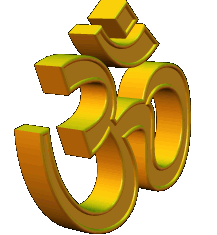
Sri Vasavi Kannika Parameswari Amman Temple
This temple, situated in Vysial Street is dedicated to Goddess Sri Vasavi (an incarnation of mother Goddess). The Garbha Griha (sanctum sanctorum) of the temple is unique in many ways. It is made of ruby red granite in three dimensional Khalasam (celestial vessel) . Apart from the main deity, the temple houses the deity of Lord Rama with Devi Sita, Sri Lakshman, Sri Hanuman, Sri Raja rajeswari, Sri Murugan, Sri Ganesh and Navagrahas.
The temple is open From 6.00 am to 5.00 pm; but will kept closed at noon. Navarathri festival that falls in the month of September is celebrated here with much enthusiasm.
Perur Patteeswara Swamy Temple
Located 6 km towards the west of Coimbatore on the Siruvani road, Perur Patteeswara Swamy Temple is dedicated to Lord Shiva. Here the presiding deity is known as 'Patteeswarar' and his consort Goddess Parvati is known by the name 'Panchanayaki'. Perur temple is closely related to Shiva’s cosmic dance and the 'Swayambu Lingam' is the idol worshipped here. This ancient temple stands on the banks of the holy river Noyyal called 'Kanchi Manadi' by the locals is one of the best known Shivastalams of the Kongu region. The temple is also known by the name Arulmigu Patteswarar Thirukoil.
Perur temple is a unique blend of fine sculpture and exquisite architecture. There is a legend behind the constrution of this temple. According to that, a calf of Kamadhenu while playing in the Arasu trees forset. hit on a hard object and blood gushed out from it. Later a sacred ‘Siva Lingam’ was discovered from that place which led to built a temple here. The Garba graha, i.e the sanctum sanctorum that enshrine Lord shiva in the form of Shivalingam is believed to be built by the Chola monarch, Karikala Cholan. Chola, Hoysala and Vijayanagara rulers have gave architectural contributions to this temple during their time in power. Images of Kamadhenu and Bhoga Shakti are enshrined in the walls of the sanctorum. The inner circumambulatory passage that surrounds the sanctum sanctorum has images of 63 Saivite saints, Sahasra Lingam, Bhairavar, Surya and Chandra.
The major attraction of the temple is the Kanaka Sabha or the ‘golden hall’, supposed to be built in the 17th century by the ruler Alagadri Nayaka of Madurai. It is exquisitely garnished with a gold plated statue of Nataraja showering blessings upon two sages namely Gowmuni and Pattimuni. The gopurams and pillars of the hall have beautifully carved out sculptures highlighting the Dravidian architecture.
At the entrance, the temple has prominent figures of the Indian soldiers. Holy palm tree Irava Panai (the deathless palm) and a holy Tamarind called Pirava Pule (the unborn Tamarind) can be seen within the temple compound. Pilgrim from all over visit this temple to pay homage to their ancestors, as it is believed that after about 144 days the mortal remains of the dead turn in to white stones. On the bank of the temple tank, there are two additional temples to Shiva and one of these temple is known as Arasambalavaanar temple. Besides these, there are also shrines dedicated to Bhairavar and Nataraja.
Perur temple celebrates the festival 'Panguni Uthiram' in its full spirit during the month of March. The annual temple festival is celebrated in the tamil month of Pankuni. During September, Perur Natyanjali dance festival is held where dance programs by leading artistes are hosted within the precincts of the temple. Chitrai (Tamil New Year), Aadi (Pooram and Ammavasai), Purattasi (Navarathri), Ayppasi (Soora Samharam), Karthigai (ThiruKarthigai), Margazhi (Aarudra Dharisanam), Panguni (Uthram) are some of the auspicious occasions celebrated in the temple.
The temple is kept open for worship
From 5.00 AM to 12.00 PM and 3.00 PM to 08.00 PM.
Contact Address :
Arulmigu PatteswararThirukoil
Siruvani Main Road, Perur
Coimbatore - 641 010
Phone: 0422 2607991
Marudhamalai Murugan Temple
Dedicated to Lord Murugan, Marudhamalai Murugan Temple located on a scenic hillock at a height of 600 feet, is about 12 Kms from Coimbatore railway station. Murugan in the form of Dhandayuthapani is enshrined in the sanctum and worshipped. Marudhamalai Hills also known as Marundhumalai is abound with shrubs and bushes of medicinal properties. Due to this, the holy shrine is said to have miracle power to get rid of both physical and mental afflictions and attachments. The name Marudhamalai has a legendary origin and according to that, a siddha overcome by tiredness, take shelter under the shade of a Marudha tree and pray to God to help him to quench his thirst. Suddenly water sprinted out from the roots of the tree and leaped in joy, the saint worship Muruga as the Lord of Marudhajalapathi. With the passage of time, the place came to known as Marudhachalapati and later marudhamalai.
On the south east slope of the temple, there is a shrine called 'Pambati Siddhar Cave'. It is said that a snake charmer who became a Siddha used this cave for worshipping Lord Muruga and attained salvation. A naturally formed rock image of a snake is a prominent feature of this temple. There are two springs on the hill namely 'Marudha Thirtam' and 'Pambatti Sunai' which is believed to cure a number of diseases.
Apart from Thaipoosam and Thirukarthigai falls in the month of January and February, other festivals like Navarathri, Aadipperukku, Tamil New Year, Vaikasi Car festival, Karthigai Deepam, Margali pooja and Aruthira Darisanam are also celebrated here.
Temple is opened
From 6.00 am to 1.00 pm and 2.00pm to 8.30 pm. Daily four different poojas are conducted here.
Contact Address :
Arulmigu Subramaniyaswamy Thirukoil
Marudhamalai, Coimbatore-641046
Phone: 0422 2422490
Velliyangiri Temple
The beautiful Velliyangiri is located on the way to Siruvani on the sacred Velliyangiri hill in the western ghats at a distance of 40kms from Coimbatore. It is one among the five hills symbolically representing the five different faces of Lord Shiva. It is only in this temple that the devotees can have the darshan of Panchalinga. During May, the pilgrims trek to the top of the hill from Maha Shivaratri to Agninakshatram period.
Avinashi Lingeswarar Temple
Avinashi Lingeswarar Temple dedicated to Lord Shiva is one of the celebrated Shaivite temple, located 40 km away from Coimbatore and 5 km from Tiruppur. The word Avinashi means indestructible and the sanctum sanctorum of the presiding deity stands as the indestructible force here.Dating back to the 15th century, this temple believed to be built by Sundarapandiya is regarded as the first of the 7 Thevaram Sthalams in the Kongu region. The temple is also known by the names, Karunaiyaaththaal temple and Dakshina Varanasi.
The temple has some exquisite stone carvings and inscriptions. Several inscriptions reveal that the Cholas, Pandyas and the Hoysalas have made extensive endowments to the temple. The temple has 2 prakarams (ramparts) and the inner prakaram is adorned with Navaranga Mandapam. There is a separate shrine for Goddess Karunambika (Ambal) which is located to the right of the main sanctum. It is believed that worshipping the scorpion symbol sculpted behind the Goddess, one will get relief from the fear of poisonous bites, bad dreams etc.
Earlier known as Pikkoigul, the place has a history that is closely related to Shiva saint Sundaramoorthy Nayanar. The saint on his way to Tiruvanchikulam is said to have miraculously rescued a boy from the clutches of a crocodile, in a tank called Tamaraikkulam. On the shore of tank, there is a shrine dedicated to the saint and this event is commemorated during the 'Mudalai Vaai Pillai' Utsavam on Panguni Uththiram.
Several festivals are celebrated here. One among them is the 12 day long Brahmotsavam held in the month of Chittirai (mid April - mid May). This festival symbolizes the penance of Brahma on Lord shiva and the holy padhiri tree in the temple compound blossoms only during this festival. The car festival, conducted during the month of Chithirai called the Chithirai Thiruvizha, is celebrated with great pomp and pageantry. The temple's car is known for its fine wooden carvings and it is one of the biggest cars in South India.
Avinashi Lingeswarar Temple is opened from 5:00 am to 1:00 pm and from 4:00 pm to 8:00 pm. The temple is protected as a monument by the Archeological survey of India.
Velliyangiri Temple
The beautiful Velliyangiri is located on the way to Siruvani on the sacred Velliyangiri hill in the western ghats at a distance of 40kms from Coimbatore. It is one among the five hills symbolically representing the five different faces of Lord Shiva. It is only in this temple that the devotees can have the darshan of Panchalinga. During May, the pilgrims trek to the top of the hill from Maha Shivaratri to Agninakshatram period.
Masani Amman Kovil
The highly revered shrine Arulmigu Masani Amman temple alias Anaimali Masani Amman temple, situated between Pollachi (15 km south- west) and Palakkad, is about 45kms from Coimbatore. The temple is nestled amidst emerald grassland interlaced with criss-cross pathways and rivulets against the backdrop of Anaimalai Hills at the joining of Aliyar River and the Uppar stream.
Goddess Arulmigu Masani is the presiding deity here with four hands of which two of them are placed on the ground and two are raised above and the 15 feet high idol is seen in a lying posture. The two right hands of the deity hold a skull and a snake while the left hands hold a tiny drum and a trident. Apart from the main deity, Neethi Kal and Mahamuniappan are other deities worshipped here. Neethi Kal is a stone image in the temple representing the Goddess of justice with the body of a serpent. It is believed that by applying grinded red chilly paste on this deity, the lost valuables of the devotees will be restored.
Legend has it that, Lord Ram stayed in a graveyard here while he was wandering in search of Sita. The temple is always crowded with devotees, especially women, during Tuesdays and Fridays. The 18 day long annual temple festival named 'Kundam Thiruvizha' commence with flag hoisting on the new moon day of the Tamil Month Thai.
Arulmigu Masani Amman Temple,
Anaimalai - 642104,
Pollachi Taluk,
Coimbatore District.
Tamilnadu
Phone : (04253) 282337
Munnar
Munnar - "sleeping town of munnar "
Munnar - breathtakingly beautiful - a haven of peace and tranquility - the idyllic tourist destination in God's own country.Set at an altitude of 6000 ft in Idukki district, Munnar was the favored summer resort of the erstwhile British rulers in the colonial days. Unending expanse of tea plantations - pristine valleys and mountains- exotic species of flora and fauna in its wild sanctuaries and forests - aroma of spice scented cool air - yes! Munnar has all these and more. It's the place you would love to visit - it's the place you would wish never to leave- so welcome.
Tourism
Mattupetty (13 km from Munnar)
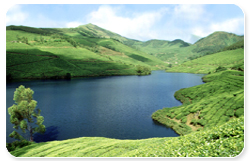
Situated at a height of 1700 Mts ,Mattupetty is famous for its highly specialised dairy farm, the Indo-swiss live stock project. Over 100 varietes of high yielding cattle are reared here.Visitors are allowed into three of the eleven cattle sheds at the farm
Visit Time : 0900 - 1100 hrs and 1400 - 1530 hrs. Rate : Rs. 5/- per head. ( liable to change)
The Mattupetty lake and dam , just a short distance from the farm, is a very beautiful picnic spot. The sprawling Kundala tea plantations and the Kundala lake are other attractions in the vicinity. DTPC Idukki provides boating facilities on the Mattupetty Dam. Speed Launch and slow speed motor boats are available on hire.
Pothamedu (6 km from Munnar)
Pothamedu offers an excellent view of the tea, coffee and cardamom plantations in Munnar. The rolling hills, the lush mountain and the breathtaking scenery here is ideal for trekking and long mountain walks.
Devikulam (7 km from Munnar)
This idyllic hill station with its velvet lawns, exotic flora and fauna and the cool mountain air is a rare experience. The Sita Devi Lake with its mineral waters and picturesque surroundings is a good picnic spot. The lake is also ideal for trout fishing.
Pallivasal (8 km from Munnar)
This is the venue of the first Hydro Electric Project in Kerala and a place of immence scenic beauty.
Attukal (9 km from Munnar)
A panorama of waterfalls and rolling hills, Attukal, located between Munnar and Pallivasal, is a feast for the eyes. The place is also ideal for long treks.
Nyayamakad (10 km from Munnar)
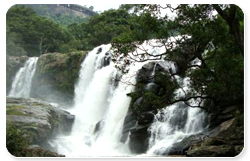
Located between Munnar and Rajamala, Nyayamakad is a land of breathtaking waterfalls. The waters cascade down a hill from a height of about 1600 meters. The enchanting surroundings makes an excellent picnic spot and trekking point.
Chithirapuram (10 km from Munnar)
With its sleepy little cottages, bungalows, old playgrounds and courts, Chithirapuram still exudes an old world charm. Home of the Pallivasal Hydel Power Project, this hill town is also famous for its picturesque tea plantations.
Lock Heart Gap (13 km from Munnar)
This is an ideal place for adventure tourism and trekking. The fresh mountain air, the mist-clad hills and panoramic view make it worthy of a visit.
Rajamala (15 km from Munnar)
The natural habitat of the Niligiri tahr , Rajamala is 2695 Mts above sea level. Half the world's population of the rare mountain goat or tahr which is fast becoming extinct, is now found here.The Niligiri tahr in Rajamala are now to be found in small herds found in Eravikulam-Rajamala region. The total number of Niligiri Tahrs in Rajamala is estimated to be over 1300.
Visiting Time : 0700 - 1800 hrs.
Visitors are not allowed during the monsoon.
Entry Pass : Rs. 10 for adults, Rs. 5 for children below 12 years, Rs. 50 for foreigners.( liable to change)
Permitting Authority : Wild Life DFO, Munnar
Eravikulam National Park (15 km from Munnar)
The 97 sq. km. park is situated in the Devikulam Taluk and is home to the Nilgiri Tahr. The Anamudi peak (2695 Mts) is located in the Southern region of the park.
Originally established to protect the Nilgiri tahr (Nilgiri Ibex), the Eravikulam National Park is situated in the Devikulam Taluk of the Idukki District. It was declared as a sanctuary in 1975. Considering the ecological, faunal, floral, geo-morphological and zoological significance, it was declared as a National park in 1978. It covers an area of 97 sq kms of rolling grasslands and high level sholas (evergreen forests). The park is breathtakingly beautiful and is easily comparable to the best mountain ranges found anywhere in the world.
Sanctuary Visit :
The park is divided into 3 regions - the core area, the buffer area and the tourism area. Visitors are allowed only to the tourism area which is in the Rajamala region. The Nilgiri Tahr can be observed at close quarters here.
Trekking facilities are available here. Tourists are allowed to go on foot up to Anamudi. This is also a place for adventure tourism.
Trekking Areas : Anamudi, Rajamala.
Power House Waterfalls (18 km from Munnar)
The waterfall on the way to Thekkady from Munnar cascades down a steep rock 2000 Mts above sea level. The spot is enriched with the scenic Western mountain ranges, and is an ideal place for a break on the way to the Periyar Wildlife Sanctuary in Thekkady.
Kundala (20 km from Munnar)
Kundala is a picturesque town on the way to Top Station. The Golf Course which belongs to Tata Tea Ltd. is located here. The Kundala artificial dam is another attraction. Aruvikkad Waterfall is also near Kundala.
CSI Christ Church
The British built the Christ Church in 1910 AD. Built of stone, the church is known for its stained glass windows. There are several brass plaques in the church placed in the memory of the tea planters.
IN AND AROUND MUNNAR
Anayirangal (22 kms from Munnar)
It's a lush green carpet of tea plants. A trip on the splendid reservoir is an unforgettable experience. The Anayirangal dam is surrounded by Tata Tea plantations and evergreen forests. It is an ideal picnic spot.
Devikulam (7 kms from Munnar)
This idyllic hill station with its velvet lawns , exotic flora and fauna and the cool mountain air offers a rare experience to visitors. The Sita Devi lake with its mineral waters and picturesque surroundings is a good picnic spot. The lake is also ideal trout fishing.
Valara (10 kms from Adimali on the Kochi-Madurai highway)
Valara has a chain of waterfalls surrounded by thick green forests.
Marayoor (40 kms from Munnar)
This is the only place in Kerala that has a natural growth of sandalwood trees. The sandalwood factory of the forest department, the caves(muniyaras) with the murals and relics from the New stone age civilization and the children's park spread across a hectare of land under the canopy of a single banyan tree, are of great interest to tourists. Thoovanam waterfalls and Rajiv Gandhi National Park are also nearby.
Cheeyappara
The Cheeyappara and Valara waterfalls are located between Neriamangalam and Adimali on the Kochi - Madurai highway.
Top Station (32 kms from Munnar)
1700 Mts above sea level , this is the highest point on the Munnar-Kodiakanal road. The rare Neelakurunji (strobilanthus) belongs to this region. Top Station (a viewing point) also offers a panoramic view of neighbouring state of Tamil nadu.
Echo Point (15 km from Munnar)
This scenic place gets its name from the natural echo phenomenon here. Echo point is on the way to Top Station from Munnar.
Meenuli
It is noted for 2 acres of evergreen forests upon a huge rock. The rock is more than 500 acres in area and an ideal spot for mountaineering.
Malankara Reservoir (6 kms from Thodupuzha)
Located on the Thodupuzha - Moolamattam road, this artificial lake is accessible by road. The reservoir is ideal for boating and fishing.
Thommankuthu waterfalls (17 kms from Thodupuzha)
The seven step waterfall here is a much loved picnic spot . At each step there is a cascade and a pool beneath . Thommankuthu is an ideal place for adventure tourism. (This is also a tricky spot and visitors are advised to exercise caution !)
Nadukani (25 kms from Idukki)
Moolamattam town , Malankara lake etc. can be viewed from the high pavilion situated here.
Kalvari mount
This is a famous pilgrim centre on the way to Kattapana.
Palkulamedu (12 kms from Idukki)
Kochi, Allapuzha and other nearby towns can be seen from this peak at 3125 mts above sea level.
Chithirapuram (10 kms from Munnar)
With its sleepy little cottages, bungalows, old play grounds and courts, Chithirapuram still exudes an old world charm. Home of the Pallivasal Hydel power project, this hill town is also famous for its picturesque tea plantation.
Ramakalmedu (16 kms from Nedumkandam)
Rolling green hills and fresh mountain air make Ramakalmedu an enchanting retreat. The hilltop also offers a panoramic view of the picturesque villages of Bodi and Kambam on the Eastern slope of the Western ghats. One can enjoy the splendid beauty of nature. This is an ideal place for trekkers and mountain climbers.
Chinnar Wildlife Sanctuary (60 km from Munnar)
Situated on the Tamil Nadu border, the Chinnar Wildlife Sanctuary is spread across 90.44 sq km.
Animals
Most of the Southern Indian wild animals can be found in this forest. These include the grizzled giant squirrel, champal squirrel, elephant, sambar deer, gaur etc.
Birds
Jungle fowl, myna, laughing thrush, black bulbul, peafowl etc.
Access
Munnar - Udumalpetta Road - 60 km
Coimbatore - Udumalpetta - Chinnar Road - 100 km
Cochin - Chinnar -190 km
Parambikulam via Pollachi - Chinnar via Udumalpetta - 60 km
Kottayam - Chinnar - 250 km
Visiting Time
0700 - 1800 hrs. Entry passes are available at the office of the Assistant Conservator of Forests or the Check Post Information Counter.
Permitting Authority
Wildlife Warden, Idukki Wild Division, Painav/Wildlife DFO, Munnar.
Trekking Routes
Palapetty, Champakad
Karimuty - Inchapetty
Karimuty - Alampetty
High Range Club
Charmingly colonial in style, this clubhouse built of wicker and teak still serves as a social centre for the far - flung farmers of the region around Munnar. The club houses an elegant lounge and a dining room, the obligatory gentleman's bar, a billiards room, a library etc. Entry is limited to members only.
Trekking Points in Munnar
Anamudi, Rajamala, Meesapulimala, Top Station, Kundala, Devikulam.
Sightseeing Tours
Sightseeing tours are arranged from the District Tourist Infornation Office, Thekkady Jn., Kumili. Tours cover spice plantations, herbal gardens, tribal settlements, other places in and around Munnar etc.
Tourist Circuits in Munnar
Munnar - Mattupetty Dam - Indo Swiss Livestock Project - Echo Point - Kundala Dam - Top Station (34 km).
Munnar - Pothamedu - Chitirapuram - Pallivasal - Cheyappara - Adimali - Valara (40 km).
Munnar - Rajamala - Marayoor - Chinnar (70 km).
Munnar - Devikulam - Lock Heart Gap - Power House Waterfalls - Anayirankal (32 km).
Geography and climate
The region in and around Munnar varies in height from 1,600 meters (5,249 ft) to 1,800 meters (5,906 ft) above mean sea level. Munnar enjoys a salubrious climate. The temperature ranges between −5 °C (23 °F) and 10 °C (50 °F) in winter and 15 °C (59 °F) and 25 °C (77 °F) in summer. The tourist season in Munnar is from August to May. However, even the monsoons are lovely with many streams and rivulets in the area and post drizzle the dew drenched tea gardens looking majestic and heavenly enshrouded in light mist .
Weather & Best Season of Munnar
Munnar experiences a moderate climate all through the year. Summers (March to May) are pleasant and the temperature ranges a maximum of 25°C to minimum of 15°C. Winters during December to February are cool and temperature comes down to 10°C during this period. Monsoons (June to September) are lovely with pouring rainfalls.
Yercaud
Yercaud is a hill station near Salem, Tamil Nadu, India in the Servarayan range of hills (anglicized as Shevaroys) in the Eastern Ghats. It is at an altitude of 1515 metres (4969 feet) above the mean sea level. The town gets its name from the lake located at its center - in Tamil "Yeri" means "lake" and "Kaadu" means "forest". Yercaud is known for coffee plantations and orange groves. It also has an orchidarium run by the Botanical Survey of India. The highest point in Yercaud is the Servarayan temple. Hence the Yercaud hill area is called Shevaroy Hills.
Attraction of Yercaud
YERCAUD LAKE

The Yercaud Lake with a picturesque pool surrounded by gardens and well-wooded trees are the first things that attract a visitor. The garden surrounding the lake is well groomed and best seen during the month of May when the Summer Festival is organised.
Lady's Seat
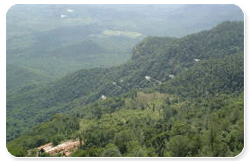
One of the best views that Yercaud promises.You get a panoramic view of the ghats and all the distant vehicles dwindling their way in and out of trees along the winding ghat road.It surely is a breath-taking view. You can have a closer view of the plains below with the help of the telescope mounted at the Lady's Seat.
This view is spectacular at night with the twinkling lights of Salem town in sight. It gives a feeling of looking over a bed of twinkling diamonds and if You are lucky to have a moonlit night..nothing could be more romantic!
KILIYUR WATER FALLS

Kiliyur Falls is a 90-foot high waterfalls is situated amidst picturesque surroundings in Yercaud. Akasagangai waterfalls is on Kolli hills which is known for medical herbs and plants.
GRANGE
GRANGE The Castle - like building was built by the then Collector of Salem, Mr.M.D. Cockburn who first introduced Coffee from Arabia, Apples and other fruits from South Africa between 1820 and 1829 A.D. It is believed to be the summer resort of Robert Clive - The British Big Wig of the East India Company way back in the late 1800's.It is now the house of My close friend and is out of bounds for tourists. So don't venture near lest You want to get bitten by a few hounds! .
PAGODA POINT
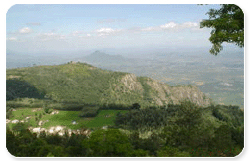
BEAR'S CAVE
It is situated near the Norton Bungalow on the way to Servaroyan Temple. A huge cave formation beside a fantastic bungalow that was supposed to play home for the bears. It is an important tourist spot worth the visit.This is also private property and since the owner has the kindness to keep it open for tourists, You have to do him a good turn by keeping the place clean and not destroying plants.
THE SERVAROYAN TEMPLE
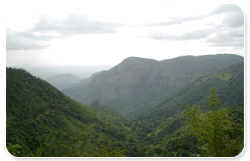
This is the third highest range in this part with a modern cave temple at its top. The hill top is bald with a real open view of all the hills around. It presents another angle of the distant town. The adjacent hill is gradually chopped (mined) off daily as it is a very rich source of Bauxite.
ANNA PARK
Anna Park is a lovely garden near the lake.Lake Park, Gandhi Park, Children Park are the other parks to be visited in Yercaud.
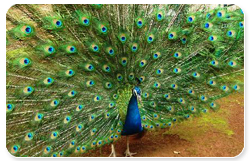
Kodaikanal
Kodaikanal - The Princes
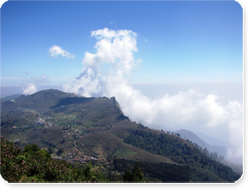
Kodaikanal is one of the most popular hill resorts in India. It is a charming hill station, stands amidst sylvan beauty on the southern crest of the upper Palani Hills near Madurai in Tamil Nadu. With its rocks, woods, lovely lake and bracing air, Kodaikanal is an ideal hill resort for the tourists.
History of Kodaikanal
The unique flowering plant 'Kurunji'(Strobilanthus Kunthanus) that last bloomed in 2004, is nature's gift to Kodaikanal. Kodaikanal located amidst the folds of the verdant Pali hills is one of the most popular serene hill stations in India, which mesmerises any visitor and is frequented all through the year.
Kodai is situated at an altitude of about 2,133-m high and covers an area of 21.45-sq-km. The hill town is renowned for its educational institutions of international repute. The hill-plantain fruits and plums are known for their freshness and taste. Berijam lake, one among the beautiful lakes of South India, spreads over an area of 24 hectares. According to the history of Kodaikanal, this hill resort was discovered in the early nineteenth century during the colonial period. It was, however, during the 1840s that the people first started settling in this place. Besides the British,the other early settlers of the place, having loving memories about Kodaikanal, were the American, French, Swedish, Irish and German missionaries.
A walking track up to Kodaikanal was made from the Kumbakarai falls, at the foothills near Periyakulam town. Only palanquins could pass through this path. Later, in the early twentieth century, the Law's Ghat road was constructed. This road was opened for regular traffic during 1920s.
The star shaped Kodaikanal lake came into existence in 1863 and it still serves as the water source of the temple city of Palani. It was only during the 1960s, that Kodaikanal started gaining importance as a tourist spot. Rich and elite Indians started setting up resorts in this place.
The 1980s was the most important time in the history of Kodaikanal. Tourismstarted booming up in this place changing the whole scenario of the region.
Places Of Interest
Kodaikanal has several scenic natural attractions which are enjoyed by its visitors and make it a popular romantic destination for newly weds. These are described in order of distance from the bus-stand.
Kodaikanal Lake
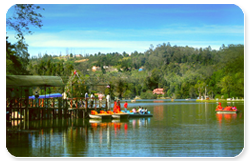
0.5 km (0.3 mi) from the bus stand, is an artificial, roughly star-shaped 45 ha (60 acres) lake built in 1863. It is recognized as Kodaikanal's most popular geographic landmark and tourist attraction. Rowboats and pedalos can be hired at the Kodaikanal Boat Club with its main entrance near the only five-star hotel in Kodaikanal, The Carlton. Horses and bicycles can be hired beside the lake for short periods. The 5 kilometers (3 mi) path that skirts the periphery of this lovely lake is a favourite walk for the locals and tourists alike.
Bryant Park
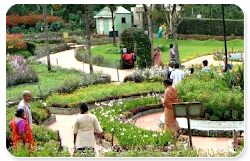
Just east of the lake and 0.5 km (0.3 mi) from the bus stand, is a wonderfully maintained 20.5 acres (8.3 ha) botanical garden. The park was planned and built in 1908 by a forest officer from Madurai, H.D.Bryant, and named after him. With 325 species of trees, shrubs and cactuses, the park is a rainbow of stunning flowers during the peak season. A large section is dedicated to nearly 740 varieties of roses. There is a 1857 Eucalyptus tree and a Bodhi tree which adds a religious significance to the park. Ornamental plants are cultivated in a nursery for sale. The park organizes horticultural exhibits and flower shows every summer, to coincide with the peak season. Entrance fee to the park is nominal and it is open all year.
Coaker's Walk

0.5 km (0.3 mi) from the bus-stand, constructed by Lt.Coaker in 1872, is a 1 kilometers (0.62 mi) paved pedestrian path running along the edge of steep slopes on the southern side of Kodai. The walk, winding around Mount Nebo, starts in front of the Van Allen hospital, running parallel to the Van Allen Hospital Road and joins the main road beside St.Peter's Church, providing a stunning panoramic view of the plains. On a clear day one can view as far as Dolphin's Nose in the south, the valley of the Pambar River in the southeast, Periyakulam town and even the city of Madurai. A fascinating rare phenomenon called Brocken spectre can be witnessed, when a person can see his shadow on the clouds with a rainbow halo. This occurs when the sun is behind the viewer and clouds and mist are to the front. There is an observatory with a telescope halfway along the walk. Entrance fee to the walkway is nominal and it is open all year.
Bear shola falls
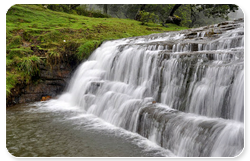
3 kilometers (2 mi) from the bus-stand, is a tall waterfall in a Reserve forest. The final approach to this quiet area is a gently climbing foot-path.
Green Valley View
(formerly called Suicide Point) 5.5 kilometers (3 mi) from the bus-stand and near the golf course, has an excellent panoramic view of the plains and a sheer drop of 1,500 meters (4,921 ft) overlooking the Vaigai Dam to the south. The stairway leading up to it is highly commercialized and lined with rows of shops to tempt tourists.
Shenbaganur Museum of Natural History
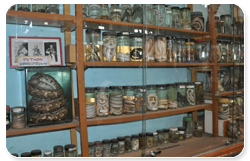
6 kilometers (4 mi) from the bus-stand, founded in 1895, is open to the public for viewing their outstanding taxidermy collection of more than 500 species of animals, birds and insects and a living collection of over 300 exotic orchid species. The museum is affliated with Loyola College in Chennai and exhibits artifacts of the ancient Palaiyar tribes people whose descendants still live in these hills.
Kodaikanal Solar Observatory
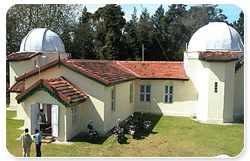
6 kilometers (4 mi) from the bus-stand on Observatory Road, at 2,343 meters (7,687 ft) is the highest location near Kodai. The first observations were commenced here in 1901. Former Director John Evershed, discovered the phenomenon of radial motion in sunspots, now known as the Evershed effect. The Kodaikanal Terrestrial Telescope can view a grand panorama including: Sothupparai Dam, Vaigai Dam, Periyakulam and Varaha river. This Indian Institute of Astrophysics facility has a comprehensive Astronomical Science museum with organized public tours, access to the astronomy library, and scheduled night-time telescopic sky viewing. It is open daily to the public during peak season, and a few hours each Friday the rest of the year.
Pillar Rocks
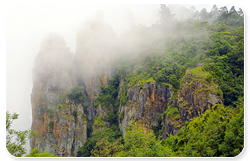
8 kilometers (5 mi) from the bus-stand, is a set of three giant rock pillars which stand 122 meters (400 ft) high. Managed by the Tamil Nadu Forest Department, The viewpoint can be crowded but is not commercialized. There is an excellent public garden adjacent to the viewpoint.
Guna caves
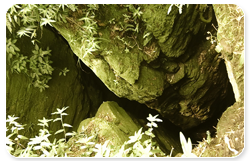
made popular by the Tamil movie Guna, previously called Devil’s Kitchen, are deep bat-infested chambers between the three gigantic boulders that are the Pillar Rocks. The deep narrow ravines of the caves are now closed to public due to the tragic deaths of twelve youths there.[citation needed] These dangerous caves are highly protected now, and tourists can see sections of the cave system from afar.
Silver Cascade
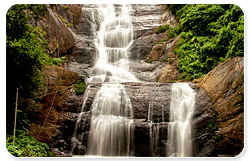
8 kilometers (5 mi) from Kodaikanal at a wide bend in the long and winding Laws Ghat Road, at altitude 1,800 meters (5,906 ft), is a 55 meters (180 ft) waterfall formed from the outflow of Kodaikanal Lake.The water quality is reportedly poor and not good enough for bathing.This impressive waterfall is a popular stop for first-time visitors. There are a few souvenir and fruit vendors and many monkeys here. There is also a smaller but more serene waterfall below the bridge which crosses the stream here.
Dolphin's Nose
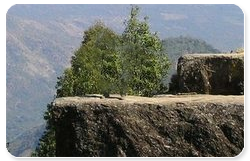
8 kilometers (5 mi) from the bus stand, is flat rock projecting over a breathtaking chasm 6,600 feet (2,000 m) deep. It is an undisturbed area 1 kilometers (1 mi) down a very steep rocky trail beginning soon after Pambar Bridge. Orange juice vendors along the trail offer a welcome rest stop. Beautiful views of steep rocky escarpments rising from the plains can be seen. The old village of Vellagavi can be reached through a rugged bridle path here. A short paved walkway leads from the road here to Pambar falls(which is also locally addressed as 'Liril Falls' after the famous Liril Soap Advertisement filming in 1985).
Kurinji Andavar Murugan temple
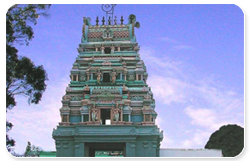
4 kilometers (2 mi) from the bus-stand, is famous for its Kurinji flower which blossoms in the area only once every 12 years. The deity here is called Sri Kurinji Easwaran, who is in fact Lord Murugan. This temple was built in 1936 by a European lady, who on coming to India, converted to Hinduism. She changed her name to Leelavathi and married a Mr.Ramanathan. She is also known as Lady Ramanathan. This temple is under the management of Arulmighu Dhandayuthapani Swamy Thiru Kovil, Palani
Madurai
Madurai - The Temple City
Madurai is one of the oldest continually inhabited city in the Indian peninsula, with a history dating all the way back to the Sangam period of the pre-Christian era. It was the seat of power of the Pandyan empire. The Sangam period poet Nakkeerar is associated with some of the Tiruvilayaadal episodes of Sundareswarar - that are enacted as a part of temple festival traditions even today. As early as the 3rd century BC, Megasthanes visited Madurai. Later many people from Rome and Greece visited Madurai and established trade with the Pandya kings.
In legend, the original town of Madurai, traditionally called ThenMadurai or Madurai of South was destroyed by a tsunami in ancient Kumari Kandam. The new city was home to the last Tamil Sangam in the early part of last Century. The great national poet Subramanya Bharathi worked as a Tamil language pandit / teacher in Sethupathy High School during the early 20th century. There is a village town in the neighbouring district of Dindigul called Vada Madurai, and another in the neighbouring district of Sivagangai called Manamadurai.
Madurai flourished till 10th century AD when it was captured by Cholas, the arch rivals of the Pandyas. The glory of Madurai returned in a diminished form in the earlier part of this millennium as it later came under the rule of the Vijayanagar kingdom and Madurai was ruled by the Nayak Emperors, the foremost of whom was Tirumalai Nayakar.
The Temple City
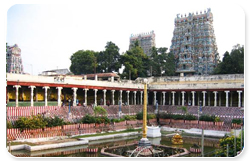
Tourism and Landmarks
Madurai is one of the most important Hindu pilgrimage sites of India. The city attracts a large number of pilgrims and tourists from within the country and abroad. About 4,100,000 tourists visited Madurai in 2007, out of which foreigners numbered 224,000.
Sri Meenakshi - Sundareswarar Temple
Madurai's Meenakshi-Sundareswarar temple, which stands today as one of the India's greatest cultural and architectural landmarks, was originally built by the early Pandya King Kulasekara. It is also one of the greatest Shiva Temples of Tamilnadu. The labyrinthine Meenakshi Temple, celebrating the love of the Meenakshi goddess and her groom Sundareswarar(the Handsome God) is of world renown. The ancient city of Madurai was supposedly laid out in a lotus-like formation, with the temple at the center and the streets and main thoroughfares layered one after the other concentrically, outward from the center. One legend says that on the day the city was to be named, Lord Shiva blessed the land and its people while divine nectar showered on the city from his matted locks. The city hence came to be known as Madhurapuri meaning The City of Divine Nectar. The legend is likely a late tale attempting to Sanskritise the otherwise-Dravidian derivative of Madurai. This is the place where Lord Natarajar performed the dance raising his right leg . (Kal maariya Aadiya natarajar). Lord shiva was very happy with the temple construction and performed a different dance. This is the temple which survived after Kannagi burnt the complete city. All of the towers are currently draped in scaffolding and opaque coverings obscuring the sculptures at least until the end of 2009.
Timings : The temple is usually open between 0500hrs and 1230hrs and again between 1600 hrs and 21.30 hrs.
Thiruparankundram - Temple
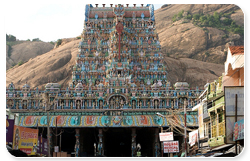
Thiruparankundram is about 8 km or 5 miles from the Madurai city center.Thiruparakundram temple has become a symbol of the religious harmony as of the people of Madurai. The traditional legend is that Lord Murugan married Deivanai at Thiruparankundram Murugan Temple, which also is the first among the Six Holy Abodes of Murugan (Arupadai Veedu, literally "Six Battle Camps") This evocative cave temple is much older and has a more sacred atmosphere than the Meenakshi temple, particularly on Fridays, when women place candles or sit around the temple floor and create kolams or rangoli patterns on the ground using coloured powders, ash and flowers as an offering to goddess Durga

Koodal Azhagar Koil - Temple
A beautiful vishnu temple which has Navagraham also(Usually Navagraham is found only in shivan temple). There is a hayagrivar temple close to this temple where hayagrivar (Horse/"haya"griva avataram) is the main deity. Most of the students do their regular prayer here as hayagrivar is the one who brought the epic fallen into water back to the earth. This is one of the temple found in center of city. This is located 100 mtrs north to the Kazimar Big Mosque (Periya pallivasal) and to the south of Sunnambukara street.
Tourist Attractions Around Madurai
Madurai acts as a tourism hub of south Tamil Nadu because of its strategic location.There are various tourist visiting places around madurai. Gandhi Museum
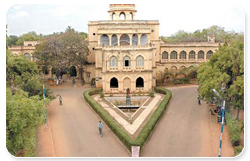
The museum displays information about Mahatma Gandhi, and most importantly it showcases the original blood-stained garment of Gandhi when he was assassinated by Nathuram Godse. The other piece of the garment is kept at the Gandhi Museum in Delhi. This museum, is one of the 5 museums in India (others in Mumbai, Barrackpore, Sabarmati and Patna) known as Gandhi Sanghralayas. Also lot of pictures taken during the Life time of Gandhi with various leaders all around the world and also during various incidents of freedom struggle is kept. Martin Luther King Jr. visited the museum during his tour of India in 1959 and is said to have got his inspiration to launch a series of peaceful agitations against racial discrimination .No entry fee for museum visitors.
Thirumalai Nayakar Mahal
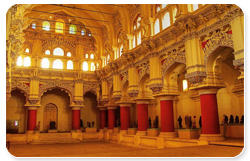
This palace complex was constructed in the Indo-Saracen style by Thirumalai Nayakar in 1636. It is a national monument and is now under the care of the Tamil Nadu Archaeological Department.
The original palace complex was four times bigger than the present structure. It was divided into two parts, Swarga-vilasa and Ranga-vilasa. In each of these there are royal residences, theater, shrines, apartments, armory, palanquin place, royal bandstand, quarters, pond and garden. The ceilings are decorated with large paintings showing Shaivite and Vaishnavite themes.
The portico known as Swarga Vilasam is an arcaded octagon wholly constructed of bricks and mortar without the support of a single rafter or girder. The stucco work on its domes and arches is remarkable. The gigantic pillars and structures represent architectural mastery. The courtyard and the dancing hall are central attractions for visitors. There are 248 pillars, each 58 feet tall and 5 feet in diameter.
Furniture and utensils used by the kings is on exhibit inside the palace. The palace is equipped to perform "Light and Sound" shows depicting the story of "Silappathikaram", in both Tamil and English languages.
Alagar koil

Azhagar Kovil, located about 25 km from the city, is a vishnu shrine. The location is surrounded by hills. The principal god of the shrine is that of Lord Kallazhagar. The Tamil new year festival called Chittirai Thiruvizha has been celebrated for centuries in this temple. In the entrance of the Azhagar kovil one can view the Badhri Narayanan temple, built similar to Badrinath near Mount Kailash in northern India: the principal idol in this shrine represents Vishnu in a meditative posture, flanked by Nara-Narayan.
The Lord Kallalagar is said to visit the temple on the eve of the Chittirai festival, one of the famous festivals in Tamil Nadu. He starts the journey from the Alagar Koil, crossing the Badri Narayanan Shrine.[1] During this time, he visits Vandiyur, near the Vaigai River, on the eastern outskirts of Madurai. It is believed that he realizes he is too late for his sister's wedding, so refuses to cross the river, and returns disappointed to Alagar Koil. On the top of the hills, is a shrine of Lord Muruga, popularly known as Pazhamudircholai. This is the last of Murugan's arupadai veedu and he is seen along with his consorts, Deivanai and Valli
Mariamman Teppakulam
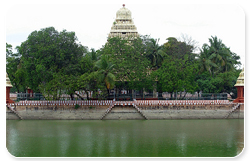
Mariamman Teppakulam is a beautiful square tank spread over a huge area of almost 16 acres, located about 5Kms East of Meenakshi Temple. The tank is the scene of the colourful float festival held in January/February to celebrate the birth anniversary of King Thirumalai Nayak, who built this tank. The deities of Meenakshi and Sundareswarar are placed in a float, called “Teppam”, decorated with flowers and illuminated with hundred of lights. This float is taken around the tank to the sound of traditional music. On the Northern side of the tank a temple is dedicated to Mariamman , a famous village deity of Tamil Nadu. Kodaikanal Around 120 km away from Madurai is Kodaikanal, one of the most beautiful hill stations in India. It is also known as princess of Hills. Kodai is located 2,130 m above the sea level in the Western Ghats.
Vaigai Dam
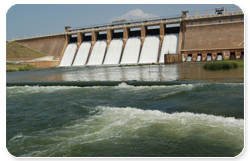
About 70 km from Madurai on the way to Thekkady is Vaigai Dam. The dam offers a breathtaking sight on weekends when it is illuminated.
Thekkady / Kumily

hekkady is one of the world's most fascinating natural wildlife reserves - the Periyar Wildlife Sanctuary. Spread across 777 km², of which 360 km² is thick evergreen forest, the Periyar Wildlife Sanctuary was declared a Tiger Reserve in 1978. It lies 155 km from Madurai and is home to many animals and birds.
Coutrallam (near Tirunelveli)
It lies 160 km from Madurai and is famous for its waterfalls. Popularly known as the 'Spa of the South', it is blessed with immense natural beauty.
Suruli Falls
Situated amidst rich flora and fauna, Suruli Falls serve as a perfect picnic spot. They lie on the way to Thekkady, at a distance of 123 km from Madurai.
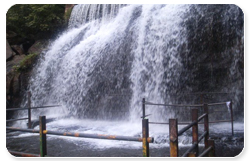
Rameswaram
A holy town located on the Pamban island in the Gulf of Mannar, Rameswaram is connected to the mainland by the Indira Gandhi (Pamban) Bridge, which is regarded as one of India’s engineering wonders. Apart from the temples, the beaches of Rameswaram are also worth a visit. The town lies 160 km from Madurai and it is connected by rail and bus.
Palani Hills
Located at a distance of 122 km from Madurai, Palani Hills are of great religious importance for Hindus. The major attraction of the hills is a temple, dedicated to Lord Subramanya.
Festivals
Pongal ( Harvest festival) January
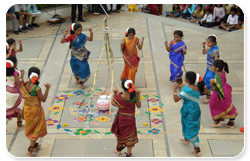
Pongal or the Harvest Festival is celebrated by way of paying tribute to the Sun, Nature and cattle for helping them with a rich harvest. The 3 day festival is celebrated with great pomp and splendour. Bogi is celebrated the first day. Homes are given a fresh lick of paint and old articles are removed. The second day is Pongal, the main festival. Sugarcanes, Pongal (a sweet variety of rice) and festoons of mango leaves mark this auspicious day. Mattu Pongal is celebrated the third day. On this day people pay tribute to the cattle for bringing in prosperity.
Jallikattu(Taming the Bull)
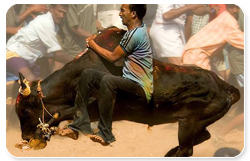
he most popular sport in Tamil Nadu is part of the pongal celebrations. This gave of valour is held in the villages with great pomp and splendor though only as a popular sport. People from the neighbouring villages throng the open grounds to watch man and beast pitting their strength against each other.
Chithirai Festival
April/May

It is celebrated every year on the Full moon day of the Tamil Month Chithirai. (April/May). Legend says that Lord Vishnu, as Alagar, rode on a golden horse to Madurai to attend the celestial wedding of Goddes Meenakshi with Lord Sundareswarar (Lord Siva). This festival is marked by solemnity and serenity
Festival of the Cradle
During the festival the deities - Goddess Meenakshi and Lord Sundareswarar (Lord Siva) are taken in procession to a mirror chamber. For nine days they are on a swing, which rocks gently.
Avanimoolam Festival
September
This festival during September celebrates the coronation of Lord Sundareswarar (Lord Siva). A “Lila” or play is performed where the temple priest recite the stories of Lord Siva in 64 miracles, which protected the city of Madurai from adversity.
Navarathri ( Nine nights) festival
This festival is held in honour of Goddess Meenakshi in all her forms, which embody fury, compassion and wisdom. During this nine day festival, Goddess Meenakshi is offered nine varieties of rice meals and nine varieties of flowers.
Dance Festival
January/ March/ November/ December
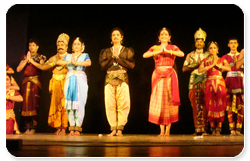
A dance festival is being organized by the Tourism Department for Fifteen days. Exponents of various dances forms from all over the country perform in this festival.
The Aadheenam
This is one of the oldest mutt in India constituted during the period of Thirugnana Sambanthar.There are lot of immovable properties donated for this mutt, right from the day of its origin. The tradition of madurai Aadinam goes back to 1300 years and Thirugnana Sambanthar being the 1st Maga Sannidhaanam The Madurai Aadheenam. The mutt is headed by the Guru Maga Sannidaanam, The Aadinam of madurai. Though being a saiva, the Aadheenam is considered as the religious head of all Saiva and vaishanava hindus of madurai. The Guru maga sannidanam, Arunachalam Swamy is the present Aadinam and he is 292nd Aadinam in their genealogy. The present Aadeenam is very well versed in the Knowledge of Vedas, Quraan and Bible. The aadinam takes parts in all major festivals of madurai connected with Hindu religion and also in religious harmony meetings. Kumbhabishekams, Meenkshi-Shokkar marriage, Azhagar's entry into vaigai and other Hindu festivals in the city are headed by the Aadinam. The sitting Aadinam, during his life time appoints his junior, who succeeds him after his death.
Entertainment
The city houses the following weekend spots:
Athisayam water theme park
The water park situated on the outskirts of Madurai (20 km from the city) attracts people of all age groups and from different places in and around Madurai. Several high-tech entertainment games offer interesting experiences to visitors. The park is scientifically designed and perfect during the summer heat.
Eco park:
The park situated near city corporation building where the lighting and fountain arrangements are impressive and the illuminated optic fiber trees add luster to the beauty.The most attractive thing in the park is the water show with music.
Hava valley:
It is located on the Natham road in the outskirts of Madurai. This place is filled with natural beauty with the hills in the backdrop. It houses a restaurant and also a go-kart track.
Rajaji children park:
It is situated in between the Gandhi museum, and the Tamukkam grounds. It has lots of children play with some hotels like Poonga Arya bhavan and some other eateries shops. Also there are some collection of birds and some Light and music play. This park is run by madurai corporation within its limits.
MGR Race Course Stadium:
It is an athletic stadium which has a synthetic track. Several National Meets are held here and also International Kabadi Championship was held here.
Arasaradi Ground :
It is the only cricket stadium in the city.
Geography and Climate
Madurai city has an area of 52 km within an urban area now extending over as much as 130 km, and it is located at 9°56′N 78°07 9.93°N 78.12°E. It has an average elevation of 101 meters above mean sea level. The climate is dry and hot, with North East Monsoon rains during October-December. Temperatures during summer reach a maximum of 40 and a minimum of 26.3 degrees celsius,though temperatures over 43 degrees celsius are not uncommon. Winter temperatures range between 29.6 and 18 degrees Celsius. The average annual rainfall is about 85 cm.
Rameshwaram
Rameshwaram History
Rameshwaram is an island- of Lord Rama's temple at Tamil Nadu is a terrific destination. Along with being a major pilgrimage for the Hindus, Rameshwaram is a happening holiday spot too.The religious island is spread in an area of 61.8 square kilometers and happens to be in the shape of a conch. The Ramanatha Swamy Temple occupies major area of Rameshwaram. The masterpiece of Dravidian architecture boasts of the largest temple corridor in India. Different rulers built the Ramanatha Swamy Temple over a period of time starting from the 12th century. The temple comprises of twenty-two wells where the taste of the water of each well is different from the other. The waters of the wells are believed to possess medicinal properties.
Rameshwaram is where Lord Rama rested and prayed after his triumph over the demon king Ravan. A sacred site for both Vaishnavites and Shaivities, no Hindu pilgrimage is complete without a visit to this holy city. The island of Rameshwaram is one of the most venerable temple towns in India without a visit to which, the pilgrimage of a devout Hindu is not complete. According to the epic Ramayana, Lord Rama(an incarnation of Lord Vishnu, the protector), rested here before and after his battles with Ravana, the demon king, in Sri Lanka, just 24 kilometers away.
Magnetic pull of the town
Ramanathaswamy Temple

A fine example of late Dravidian architecture, this temple is most renowned for its magnificent corridors lined with massive sculptured pillars, noted for their elaborate design, style and rich carving. Legend has it that Rama sanctified this place by worshipping Siva here after the battle of Sri Lanka. Construction of the temple began in the 12th century AD and additions were made over the centuries by various rulers, so that today its gopuram is 53 m high. Only Hindus may enter the inner sanctum.
Kothandaraswamy Temple & Dhanushkodi
Twelve km from town, this temple was the only structure to survive the 1964 cyclone which washed the rest of the village away. Legend states that Vibishana, brother of Sita's kidnapper Ravana, surrendered to Rama at this spot.
Adam's Bridge
Adam's Bridge is the name given to the chain of reefs, sandbanks and islets that almost connects Sri Lanka with India. According to legend, this is the series of stepping stones used by Hanuman to follow Ravana, in his bid to rescue Sita.
Beach
Dhanushkodi is the best. Closer to town, try the one in front of the Hotel Tamil Nadu. Most of the time you'll have it to yourself as the pilgrims prefer to do their auspicious wading at Agni Theertham, the seashore closest to the temple.
Gandhamadana Parvatam
The stepped mandapam or hall, about a mile and a half west of the Ramanathaswamy Temple offers an excellent view of the countryside. There is a footprint here believed to be of Lord Rama.
Temple View
ameshwaram is significant for the Hindus as a pilgrimage to Benaras is incomplete without a pilgrimage to Rameswaram. The presiding deity here is in the form of a Linga with the name Sri Ramanatha Swamy, it also happens to be one of the twelve Jyotirlingas.
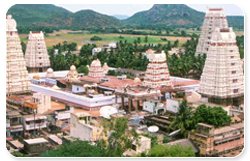
The masterpiece of South Indian architecture boasts of the largest temple corridor in India. Different rulers built the Ramanatha Swamy Temple over a period of time starting from the 12th century. The temple comprises twenty two wells where the taste of the water of each well is different from the other. The grandest part of the temple is the 1219 m pillared corridor consisting of 3.6 m high granite pillars, richly carved and well proportioned. The perspective presented by these pillars run uninterruptedly to a length of nearly 230 m.
According to the Puranas, upon the advice of Rishis (sages), Rama along with Sita and Lakshmana, installed and worshipped the Sivalinga here to expiate the sin of Brahmahatya (killing of a Brahmin) (Ravana was a Brahmin the great grandson of Brahma). Rama fixed an auspicious time for the installation and sent Anjaneya to Mount Kailas to bring a lingam. As Anjaneya could not return in time, Sita herself made a linga of sand. When Anjaneya returned with a linga from Mount Kailas the rituals had been over.
To comfort the disappointed Anjaneya, Rama had Anjaneya’s lingam (Visvalingam) also installed by the side of Ramalinga, and ordained that rituals be performed first to the Visvalingam.
In Rameshwaram Temple, a spiritual "Mani Darshan" happens in early morning everyday. This "Mani" is made of "sphatik"[a precious stone] and in form of "Holy shivling". according to ved this is "Mani" of "sheshnag".
Sethu Karai is a place 22 km before the island of Rameshwaram from where God Ram is claimed to have built a Floating Stone Bridge Ramasethu till Rameshwaram that further continued from Dhanushkodi in Rameshwaram till Talaimannar in Sri Lanka as mentioned in the great Hindu epic Ramayana.
Pamban Bridge
The Pamban Bridge on the Palk Strait connects Rameswaram to mainland India. It refers to both the road bridge and the cantilever railway bridge, though primarily it means the latter. It was India's first sea bridge. It is the second longest sea bridge in India (after Bandra-Worli Sea Link) at a length of about 2.3 km.
From the elevated two-lane road bridge, adjoining islands and the parallel rail bridge below can be viewed.

The railway bridge is 6,776 ft (2,065 m) and was opened for traffic in 1914. The railroad bridge is a still-functioning double-leaf bascule bridge section that can be raised to let ships pass under the bridge.
The railway bridge historically carried meter-gauge trains on it, but Indian Railways upgraded the bridge to carry broad-gauge trains in a project that finished Aug. 12, 2007. Until recently, the two leaves of the bridge were opened manually using levers by workers. About 10 ships — cargo carriers, coast guard ships, fishing vessels and oil tankers — pass through the bridge every month.
According to Dr Narayanan, the bridge is located at the "world's second highly corrosive environment", next to Miami, US, making the construction a challenging job. The location is also a cyclone-prone high wind velocity zone.
Location
The bridge spans a 2 km-strait between mainland India and Rameshwaram island and is the only surface transport link between the two. The mainland end of the bridge is located at 9°16′56.70″N 79°11′20.12129.2824167°N 79.188922556°E
The straight, part of the larger Adam's Bridge (also known as Rama's Bridge), is famous for the bridge and scenic beauty. The channel was not damaged in the 2004 Indian Ocean Earthquake and tsunami.
Kanyakumari
Kanyakumari - The Southern most Land tip of India
Kanyakumari (also spelt as Kanniyakumari) district is bounded by Tirunelveli district in the north and northeast, by Kerala state in the northwest and confluence of Arabian Sea and Indian Ocean in the west and south. The coastline is almost regular except for some points of land projecting into the sea at Cape Comorin. Kanyakumari is the district headquarters of the district of the same name.
It's Name
Kannyakumari has been named after the Goddess Kannyakumari Amman who is the popular deity of the area. Legend has it that the Goddess Parvati in one of her incarnations as Devi Kanniya did penance on one of the rocks of this land's end to obtain the hand of Lord Shiva.
The City Of Kanyakumari
At the southern most land tip of India, where the Arabian Sea, the Indian Ocean and the Bay of Bengal meet, lies Kannyakumari, an important pilgrim centre. Kannyakumari is famous for its beach and the spectacular sunrises and sunsets, especially on full moon days. Kanyakumari is also famous for its vast green stretches of paddy fields, rich forests, coconut groves and mineral sands.
Kanyakumari Beach
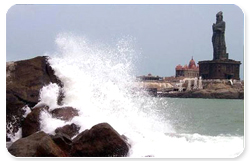
The Kanyakumari beach is a beautiful sight with multi-coloured sand. The beach here does not really offer one the opportunity to sunbathe on soft golden sands, or to frolic in the waves either. The seashore is rocky and dangerous, and there is a manmade wall running along it. People are warned to stay off the rocks, and when if someone ventures out of bounds, he or she is quickly and severely reprimanded by a watchful policeman. There is a lighthouse from where one can get a panoramic view. The sea is fairly rough, so it is entertaining to watch it beat itself against the rocks and then subside, before it gathers itself up for another attack. With long stretches of sands of many hues, the beach offers a welcome change. A variety of shells are on sale on the Kanyakumari beach.
The History Of Kanyakumari
Kanniyakumari district, once known as "The Granary of Travancore" lies at the southwestern part of Indian peninsula. It was in Travancore for a long time and then merged with Tamil Nadu in 1956 under the State Linguistic Reorganisation Act.
Pilgrim Rites Performed Pilgrimage rites include bathing at Pitru and Matru Tirtha, two rocks over which a monument honouring Swami Vivekananda, a Hindu religious leader, was built in 1970.
Attractions of Kanyakumari
Temple Of Goddess Bhagavathi
Few temples in India are more picturesquely located than that of Goddess Bhagavathi in Kannyakumari. It stands near where three oceans meet: the Indian Ocean, the Bay of Bengal and the Arabian Sea.
In its early form the temple seems to have been built by the first Pandyas. The Nayaks expanded it later. There are three Prakaras. The image of the Goddess in the sanctum is marvellous in its serenity and beneficence. She carries a necklace in Her right hand. The eastern gate, facing the Bay of Bengal is opened only five times a year.
Swami Vivekananda Rock Memorial

On the evening of December 25, 1892, Swami Vivekananda who had come to Kannyakumari on pilgrimage swam to the rock and spent the whole night there in deep meditation. He then resolved to decide himself to the service of the Motherland and to spread the message of Vedanta. Next year he attended the Parliament of Religions in Chicago, an event of seminal importance in the modern history of Hinduism. To commemorate his visit to the rock a superb memorial has been erected. It attracts thousands of visitors.
Kumari Amman Temple
Kumari Amman Temple is dedicated to Parvati as Devi Kanya, the Virgin Goddess who did penance to obtain the hand of Lord Shiva.
The Temple At Suchindram
Tradition connects the Kannyakumari temple with that in Suchindram (13-km from Kanyakumari). This is a fine, large fane, with a beautiful tank. It is one of the few temples in the country where the Trinity, Brahma, Vishnu and Isvara, are worshipped. The Linga, named "Sthanumalaya", is in three parts; the top represents Lord Shiva, the middle Lord Vishnu, and the base Lord Brahma. "Sthanu" is a name of Shiva, "Mal" of Vishnu, and "Ayan" of Brahma.
Gandhi Mandapam
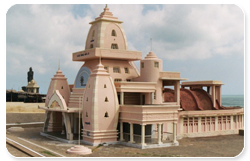
Not far from the Kumari Amman Temple is the Gandhi Mandapam, constructed at the spot where the urn containing the ashes of Mahatma Gandhi was kept for public view before a portion of its contents was immersed in the three seas. It resembles an Oriyan temple and was designed so that on Gandhiji's birthday (2nd October), the sun's rays fall on the place where his ashes were kept.
Other Attractions of Kanyakumari
Thengapattinam Beach
Thengapattinam, situated on the west coast, is a place of historical importance. It is 35-km from Nagercoil and 54-km from Kannyakumari. As coconut trees are abundant in this place, the place might have derived this name. This village had, in ancient times, trade relations with foreign countries like Arabia. There was direct Cargo boat service between Thengapattinam and other foreign maritime towns. The mosque at Thengapattinam is about 1,200 years old. This place is well connected with Nagercoil and Thiruvananthapuram by regular bus service. Thengapattinam Beach is an excellent picnic spot with backwater facilities.
Pechipparai Dam
Like all other dam sites Pechipparai Dam too is a popular picnic spot where facilities for boating have also been provided. It is 56-km from Kanyakumari.
Chidaral 55-km from Kanyakumari is Chidaral. The Jain sculptures here are worth a visit.
Vattakottai
About 6-km from Kannyakumari is Vattakottai with an 18th century fort overlooking the sea. The sea here is calm and suitable for bathing.
Muttam
About 32-km from Kannyakumari is Muttam with a fine beach and a lighthouse.
Padamanabhapuram
The capital of Travancore until 1333, Padmanabhapuram is known for its fort which encloses, among other buildings, a palace and a temple. The palace has some important art relics while the Ramaswami temple has exquisitely carved panels depicting scenes from the Ramayana. Padmanabhapuram is 45km from Kanyakumari.
Thiruvattar
Thiruvattar is located at a distance of 70-km from Kanyakumari. The temple here is one of the finest specimens of temple art and architecture. The paintings on the walls of the temple are worth seeing.
Thirparappu Water Falls
About 60km from Kanyakumari are Thirparappu Waterfalls, a picturesque spot with an ancient Mahadevar Temple.
Mathoor Thottippalam
It is one of the largest and the highest bridge located near Thiruvattar about 70-km from Kanyakumari. The bridge and the lush green surroundings are noted for scenic beauty.
Olakkay Aruvi Water falls
Olakkay Aruvi waterfalls in the Western Ghats are 14-km from Nagercoil and 33-km from Kanyakumari. The beautiful waterfalls and the natural scenery all around the place attract many holiday seekers and this place has become an important picnic centre.
Kalakkadu and Mundanthurai
Kalakadu wildlife sanctuary is situated in an area of 223-sq-km in the Tirunelveli district, including the foothills of the Western Ghats and the adjoining area. 47km from Tirunelveli, the Kalakadu wildlife sanctuary is very popular with botanists and ornithologists as it has a great variety of fauna and bird life.
Situated 42-km from Tirunelveli, the Mundanthurai wildlife sanctuary boasts of dry deciduous to tropical wet evergreen forest patches of pure reeds. The sanctuary covers an area of 567-sq-kms. There is nothing to differentiate this sanctuary from that of Kalakadu, except the absence of Elephant and the Gaur.
Excursions of Kanyakumari
Tirunelveli
The temple of Swami Nelliappar and Sri Kanthimathi Ambal in Tirunelveli (83-km from Kanyakumari) dates back at least to the seventh century. Sambandar has sung it, and Ninrasir Neumaran, the Pandya, is said to have commissioned the making of musical pillars in a Mandapa in this temple. Originally, there were two temples side by side, dedicated to Lord Nelliappar and Goddess Kanthimathi. They were linked by a Mandapa, the "chain" Mandapa, built in 1647. The oldest inscription belongs to the middle of the tenth century.
Sankaranainarkoil
Sankaranainarkoil has three shrines dedicated to Lord Sankaralinga, to Goddess Gomathi Amman and, between these two, to Lord Sankaranarayana, a combination of Shiva and Vishnu. The temple was built in the eleventh century and was expanded later. The Gopura is of nine storeys and is 38m high. The temple is famous for the miracles the Goddess performs in curing illness.
Nagaraja Temple at Nagercoil
19-km from Kannyakumari is Nagercoil, which contains the celebrated Nagaraja temple. The sanctum is a simple thatched shed, with mud walls. It enshrines the King of Serpents. Tradition states that a King of Kalakkad was cured of leprosy when he performed penance in the temple. He then rebuilt it in the Kerala style. He might have been Bhuthalavira Sri Vira Udaya Marthandavarma, who ruled Venad, with Kalakkad as his capital, from 1516 to 1535. It is believed that snakebite is not fatal within a kilometre of the temple. The fane has some Jain sculptures.
Alvar Tirunagari
One of the celebrated Vaishnavaite temples in the district of Kannyakumari is in Alvar Tirunagari, one of the nine sung of by Namalvar. The saint attained enlightenment under a tree, which still stands in the temple. The Lord is Adinatha. The temple has a Nadaswaram musical instrument made of stone. It is played during the temple festival.
Kumarakovil
Kumarakovil is at the foot of the Velimalai hills in Kalkulam Taluk (also spelt as Taluka), about 34-km from Kannyakumari. The Lord Muruga Temple is built on the hillock about 200 feet height in a lush green field of Paddy, Plantain and Coconut trees. The temple is noted for architectural beauty. Goddess Valli, the spouse of Lord Subramanya is also enshrined in the temple by the side of the Lord. In the right side of the temple there is one big lake, suitable for boating.
Subramanya Temple in Tiruchendur
The temple of Lord Subramanya in Tiruchendur, also in the same district, is one of the "Arupadai Veedus", or specially sanctified residences, of the Lord. It is situated by the sea. Traditionally, it commemorates the Lord's victory over Surapadma, a demon. The Gopura, of nine storeys, is 42m high and was constructed in the 17th century. It was renovated in 1983.
Fairs and Festivals
Cape Festival
Kanyakumari, also known as Cape Comorin is located at the southern most tip of India, where the Bay of Bengal, Indian Ocean and the Arabian Sea meet. A dip in the ocean here is considered holy, but the sea is rough here and not fit for bathing. This is the only place in India, where the sunset and moonrise can be viewed simultaneously on a full moon day.
The Vivekananda memorial set amidst the sea is a place known to give mental emancipation. The Cape festival is celebrated on a large scale for three days at Kanyakumari. The festival is marked by a series of cultural programs.
Places to stay in Kanyakumari
Varied accommodation options varying from luxurious to economic hotels, lodges, Devasthanam cottages are available for tourists in Kanyakumari.
Shopping in Kanyakumari
Souvenirs and handicraft articles made from seashells and palm leaf articles are the main items to buy at Kannyakumari. Trinkets and packets of coloured sea sand for children can also be bought here. There are several shops selling these articles.
Tanjore

Tanjore is the "Rice bowl of Tamil Nadu" and famous for the Brahadeeswarar Temple. The temple was constructed more than thousand years ago by the King Rajarajan, is an architect's marvel. It is a flourishing centre for bronze sculpture and painting. Thanjavur was the royal city of the Cholas, Nayaks and the Mahrattas. Thanjavur was at height of its glory during Rajaraja Cholan. The Big Temple and the other famous temples in the district are known all over the world. Thanjavur was the cultural capital of the country in 1790. Thanjavur gained prominence during the period of Chola Kings, who made it as their capital. It is known as the Granary of the South India lying in the deltaic region of the famous river Cauvery and criss-crossed by lengthy network of irrigation canals.
Kerala Backwater
Kerala has over 900 Km of interconnected waterways, rivers, lakes and inlets that make up the Kerala backwaters. In the midst of this beautiful landscape there are a number of towns and cities, which are the starting and end points of Kerala backwater cruises. These Kerala backwater destinations are a mixture of historic and modern towns and scenic holiday getaways in the backwaters of Kerala. Tourists from all over the world come to these Kerala backwater destinations to see their scenic attractions.
Backwater regions
Kollam
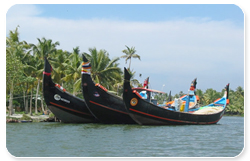
Kollam (earlier known as Quilon) was one of the leading trade centres of the ancient world, eulogised by travellers such as Ibn Battuta and Marco Polo. It is also the starting point of the backwater waterways. The Ashtamudi Kayal, known as the gateway to the backwaters, covers about 30 per cent of Kollam. The 8 hours boat ride from Kollam to Alappuzha is the longest cruise in Kerala and is delightful ride with lotuses and water lilies all around.The historic Thangasseri Fort is near Kollam, which is situated 71 km north of Thiruvananathapuram.
Alappuzha
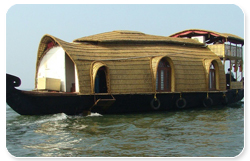
With the Kuttanad region and the Vembanad Kayal nearby, Alappuzha (earlier known as Alleppy) attracts tourists throughout the year. The criss-crossing canals in the area evoke comparisons with Venice, but the differences are also substantial. Each has an identity of its own. Amongst the notable sights is the palm covered Pathiramanal Island in Vembanad Kayal, one hour by boat from Alappuzha.The place is famous for the snake boat races and also has a number of historic colonial buildings and a beach.
Kuttanad

The Kuttanad region is a vast area of partly reclaimed land, covered with bright green paddy fields, separated by dikes. The level of water is a few feet higher than the level of the surrounding land.It is an amazing labyrinth of shimmering waterways composed of lakes, canals, rivers and rivulets. Lined with dense tropical greenery, it offers a glimpse into rural life-styles of Kerala.Kuttanad is a backwater paradise and an ideal destination for a backwater cruise in Kerala. It is possible to drift along in a houseboat and enjoy the scenic view of the Kerala countryside.
Kumarakom
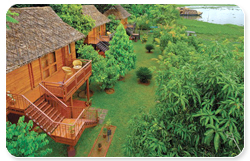
The village of Kumarakom is a cluster of little islands on the Vembanad Kayal, and is part of the Kuttanad region.The blue backwaters of Vembanad Kayal and the amazing shades of green of the vegetation, combines with the quietness of the place to make it an idyllic holiday destination. Many of the resorts also offer ayurvedic treatment.While Kuttanad is ideal for a house boat cruise, the resorts are the main attraction in Kumarakonam. One can also take a boat trip in Kumaramonam It is located 15 km west of Kottayam. The bird sanctuary and the drift wood museum are added attractions.
Srinivas, a singer summed up: “Imagine opening your eyes every morning to a sheet of still, blue water and majestic palm tress gently swaying in the breeze. To define the feeling in one sentence: Nature undisturbed by man is wonderful and inspiring, and Kumarakom is just that!”
Munroe island
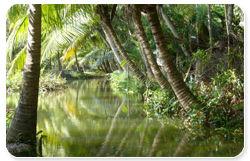
Munroethuruth or Munroe Island is a place surrounded by kallada river, Ashtamudi Lake and [[Sasthamkotta Lake]] in Kollam district ,MunroeIsland is a cluster of eight tiny islands, Blessed with a number of criss-cross canals and zigzag water channels, this Island plays a host to so many migratory birds from various countries around the world. You can watch birds such as King fisher, Woodpecker, Egret,Bee-eater, Crow pheasant, and Paddy Birds. There is yet another rare chance to see the traditional Indian spice plants such as Pepper, Nutmeg and Cloves.
The first community tourism programme in the State will start functioning from the MunroeThuruthu islands.Coir making is a home industry to almost all the village living people. It is very interesting to watch the coir making by the village ladies with the help of weaving Wheels. They make the coir ropes by hand. In addition to this, on the way, you can see the process of extracting coconut oil from the "copra" [dried coconut]. Among the routine traditional engagements, duck, poultry farm and prawn breeding are common in all houses.
Kasargod
Kasargod in north Kerala is a backwater destination, known for rice cultivation, coir processing and lovely landscape, it has the sea to the west and the Western Ghats to the north and east. Cruise options are Chandragiri and Valiyaparamba. Chandragiri is situated 4 km to the southeast of Kasargod town and takes tourists to the historic Chandragiri fort. Valiyaparamba is a scenic backwater stretch near Kasargod. Four rivers flow into the backwaters near Kasargod and there are many small islands along these backwater stretches, where birds can be seen.
Thiruvallam
Thiruvallam backwaters are just 6 km from Thiruvananthapuram, the state capital. Known for its canoe rides Thiruvallam is becoming increasingly popular with tourists. Two rivers, the Killi and the Karamana come together at Thiruvallam. Not far from Thiruvallam is the Veli Lagoon, where there are facilities for water sports, a waterfront park and a floating bridge. The Akkulam Boat club, which offers boating cruises on Akkulam Lake and a park for children, is also a popular tourist attraction near Thiruvallam.
Kozhikode
Kozhikode (also known as Calicut) has backwaters which are largely “unexplored” by tourist hordes. Elathur, the Canolly Canal and the Kallayi River are favourite haunts for boating. Korapuzha, the venue of the Korapuzha Jalotsavam is fast becoming a popular water sport destination.
House Boats

Kerala Houseboats (Riceboats) or kettuvallam are country boats that were used in the early days for the transport of goods from the isolated interior villages of Kerala Backwater area to the towns like Alleppey, Kollam, Cochin and Kottayam. With the advent of roads, bridges and ferry services, gradually the kettuvalloms went off the scene. Now these kettuvalloms are back again as a major tourist attraction as a modern moving boat house that is kerala houseboats . kerala houseboats size vary from, about to 95 feet feet in length and a width of around 13 feet to in the middle for one bedroom houseboat and , big houseboats with up 107 feet long and up to 19 feet wide. The materials that go into the making are all local and Eco friendly bamboo poles, coconut fiber ropes, bamboo mats, coir carpets etc. The main wood used is "Anjili". Kerala house boats have fully furnished single double triple and five bedrooms with sundeck, private balcony with comfortable chairs, kitchen and toilet with WC. In addition there is also separate rest room.
houseboats in Kerala have a three member crew - a chef, driver & cabin assistants. The cuisine is traditional Kerala flavor with the local specialties; delicious local fish. There are single bedroom houseboats for two people and two bedroom houseboats for four people.and 3 bedroom houseboat for 6 , and 5 bedroom houseboat for 10 People.The spectacular beauty of Kerala's backwaters needs no introduction. A Kerala Houseboats cruise along the palm-fringed waterways of Kerala in luxury houseboats is the most enchanting holiday experience in India today. In this world of simple pleasures, you will skim past ancient Chinese fishing nets, water lilies, lush paddy fields, coir villages, rustic homes, temples and coconut groves. A guided tour down the backwaters would provide you with a complete and most enchanting experience on the back waters of Kerala and will also reveal to you some interesting facts about the life of local village people. This month's lens view takes you to the backwater stretch of the Vembanad, where one can go for a leisurely cruise on a multi deck boat, allowing you enjoy the scenic backwater life.
Honey Moon
Begin your life together with an unforgettable journey to a green paradise, when you enjoy a honeymoon in Kerala Backwaters. Imagine you and your loved one relaxing on a houseboat and floating along a tranquil Kerala Backwater. Feel as if you're the only people in the world as you travel through the placid waterways. Hear no voices other than the murmur of rippling water, the whisper of the wind rustling among the palm fronds and the sound of birds calling as they fly across an azure sky. Lie back and count the stars in the velvet sky of the tropical night, as you anchor on the banks of a Kerala backwater.
A honeymoon in the backwaters is the most delightful experience one can ever have. Kerala certainly deserves the name 'the God's Own Country', with all its golden beaches, palm-fringed seashores, untouched natural beauty, and Kettuvallams--the much-famed houseboats of Kerala.
Cruise through the backwaters of Kerala in these traditional houseboats and play to the dazzling and delightful moonlight. Live out a fantasy with the lullaby of the waves and in the arms of each other as your heart skips a beat with every stirring of the seawater, which is as deep as your love for each other. You will always cherish the moments that you spend aboard the giant country crafts that are the indispensable part of the state's picturesque backwaters.
Once used in Travancore and Kochi, and in the Minicoy Islands as a cargo boat, these huge, eye-catching boats are made up of large planks of wood that are tied together perfectly using hand-made coir ropes, besides beaten coconut fibers.
Seeing the curiosity and interest they arouse in the tourists, they have now been converted into floating luxury dwelling units complete with a suite, one or two bath attached bedrooms, one living room, kitchenette, an open lounge, deck and a crew comprising oarsmen, a cook and guide. An ideal sojourn for the honeymoon couples.
Mysore

Mysore History
The site where Mysore Palace now stands was occupied by a village named Puragere at the beginning of the 16th century. The Mahishūru Fort was constructed in 1524 by Chamaraja Wondeyar who passed on the dominion of Puragere to his sonChamaraja Wondeyar (1572–1576). Since the 16th century, the name of Mayashūru has commonly been used to denote the city. The Kingdom of Mysore, governed by the Wodeyar family, initially served as a Vassal state of the Vijayanagar Empire. With the decline of that empire after theBattel of Talikota in 1565, the Mysore Kingdom gradually achieved independence, and by the time of King Narasraja Wodeyar (1637), it had become a sovereign state.Seragapatanam, near Mysore, the present-day Srirangapatna, was the capital of the kingdom beginning in 1610.The 17th century saw a steady expansion of its territory and, underNarasaraja Wodeyar and Chikka Devaraja Wodeyar, the kingdom annexed large areas of what is now southern Karnataka and parts of Tamil Nadu, to become a powerful state in the southern Deccan.
Mysore
Mysore is situated at the foothills of the Chanmundi. At an altitude of 770 m (2,530 ft) above mean sea level, the city of Mysore is geographically located at north latitude and 76° 38′ east longitude. It is about 140 km (87.0 mi) southwest of the state's capital, Bangalore, and spreads across an area of 156 km2 (60 sq mi)(City + neighbouring census towns). The population of the city combined with its neighbouring towns in its metropolitan area is about 12,88,000 in 2023.
Most of the city's development during modern times could be attributed to the maharajas of mysore and theWadiyar dynasty , who were patrons of art and culture. Hyder Ali and Tipu, when they were briefly in power in succession, also contributed significantly to the economic growth of the city and the kingdom by planting mulbery, trees and silk in the region, and fighting four wars against the British. In present days, the Mysore city corpration is responsible for the civic administration of the city.
